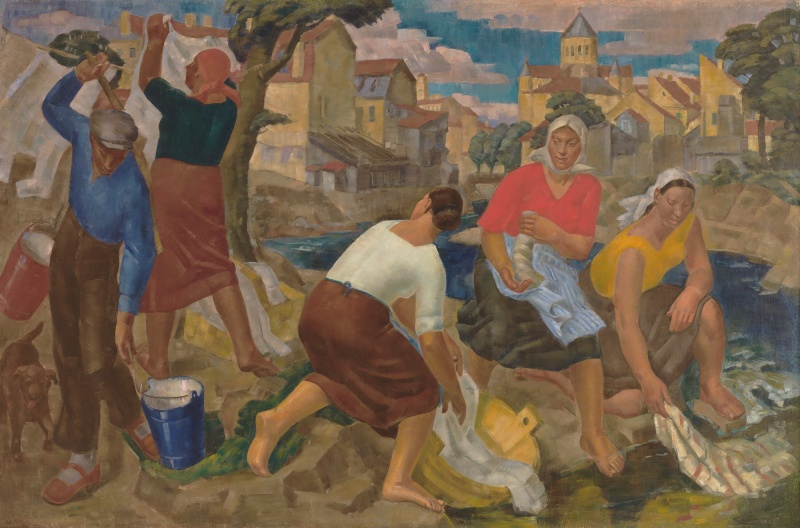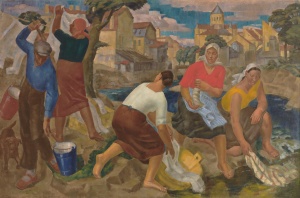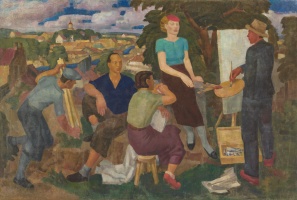

Laundresses (by the Vilnelė in Užupis)
| Author: |
Anonymous author (Anonymous graduate of the Department of Fine Art of Stephen Batory University) (20th century) |
| Created: | before 1939 |
| Material: | canvas |
| Technique: | oil |
| Dimensions: | 148 × 226 cm |
| Signature: | unsigned |
The painter of this picture has not been identified, but there is little doubt that it is a graduation work from the Department of Art at Stephen Batory University, because of its Neo-Classical style characteristic of Ludomir Sleńdziński’s teaching, and the large format of the picture. Vilnius artists in the interwar period painted similarsized canvases only as commissions for public buildings or as diploma works. Students at the Department of Art had to show their ability to work independently, by presenting a large-format figure composition on the theme of labour. Only a few of these diploma works have survived, and this makes them invaluable. This picture is interesting because of the clear and easily identifiable site of the action: the banks of the River Vilnelė by the Academy of Art, on the Užupis side, looking towards the Russian Orthodox cathedral.
Text author Giedrė Jankevičiūtė
Despite taking a new approach to traditional genres and subjects, Neoclassicism applied traditional means of expression, consisting of figurative treatment, clear drawing, and monumental and idealised forms. Artists found their inspiration in Greek and Roman art, the Renaissance, and 17th and 18th-century Classicism, which naturally led to the predominance of nudes, portraits and figurative compositions, with figures often placed against a background of urban architecture, as in the canvases Plein-air session of Vilnius University art students and Laundresses (by the Vilnelė in Užupis) by alumni of the Faculty of Art at Stephen Báthory University. The arrangement of the figures against the backdrop of Vilnius architecture, reminiscent of a historical composition, transforms a genre scene into an event on a grand scale. However, while turning to the history of art, Neoclassical artists also drew on the experience of Modernist trends (Cubism and Expressionism), and experimented with distortion and the expressiveness of the image.
Text authors Dovilė Barcytė and Ieva Burbaitė
Source: Law firm Valiunas Ellex art album MORE THAN JUST BEAUTY (2012). Compiler and author Giedrė Jankevičiūtė, KAUNAS–VILNIUS / 1918–1945 (2021). Compilers and text authors Dovilė Barcytė and Ieva BurbaitėExpositions: “More Than Just Beauty: The Image of Woman in the LAWIN collection”, 12 October – 11 November 2012, National Gallery of Art, Vilnius; "1918-1945 / Kaunas-Vilnius", 27 August 2020 – 21 August 2021, Lithuanian Art Centre TARTLE (Užupio St. 40, Vilnius). Curators Dovilė Barcytė and Ieva Burbaitė.








